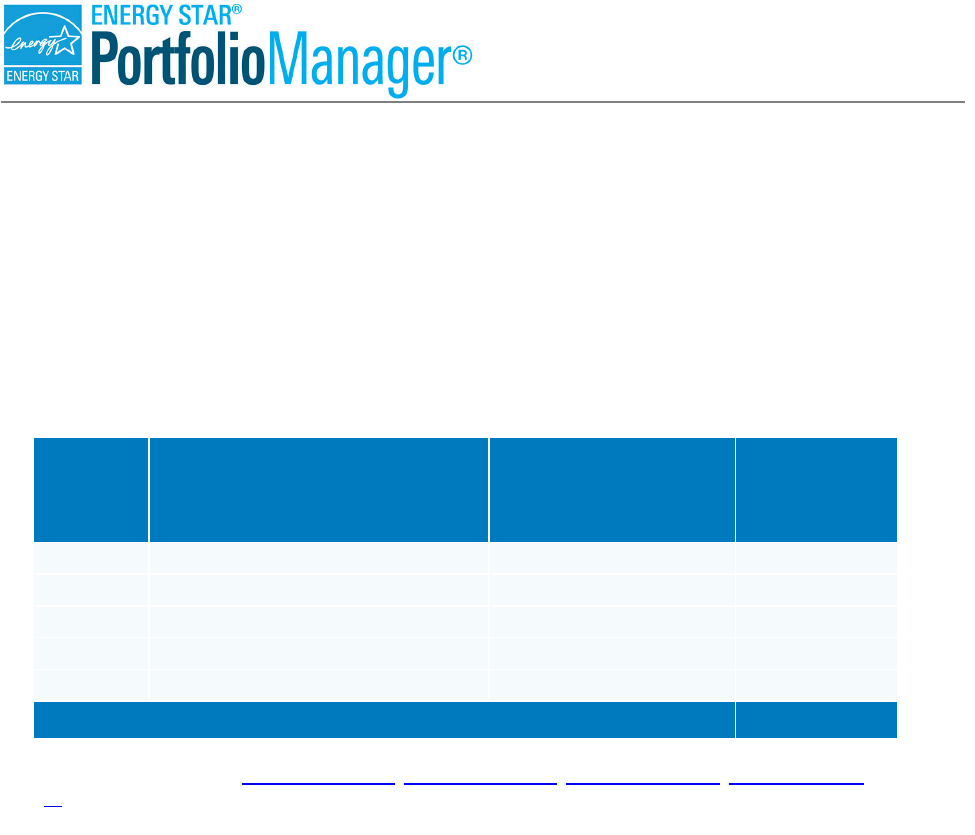
August 2023 Source Energy Page 1
Technical Reference
Source Energy
OVERVIEW
Commercial buildings use different mixes of energy including electricity, natural gas, fuel oil, district steam, and many
others. To evaluate energy performance for these buildings, we have to express these different energy types in a
single common unit. Source energy is the most equitable unit of evaluation, and enables a complete assessment of
energy efficiency.
You may be familiar with site energy, the amount of heat and electricity consumed by a building as reflected in utility
bills. Site energy may be delivered to a facility in one of two forms. Primary energy is the raw fuel that is burned to
create heat and electricity, such as natural gas or fuel oil. Secondary energy is the energy product created from a
raw fuel, such as electricity purchased from the grid or heat received from a district steam system. A unit of primary
energy and a unit of secondary energy consumed at the site are not directly comparable because one represents a
raw fuel while the other represents a converted fuel. Ultimately, buildings require heat and electricity to operate, and
there are always losses associated with generating and delivering this heat and electricity. Source energy traces the
heat and electricity requirements of the building back to the raw fuel input, thereby accounting for any losses and
enabling a complete thermodynamic assessment.
The figure below summarizes the ratios used in Portfolio Manager to convert to source energy. We use national
average ratios for the conversion to source energy to ensure that no specific building will be credited (or penalized)
for the relative efficiency of its energy provider(s).
Figure 1 – Source-Site Ratios for all Portfolio Manager Energy Meter Types
Energy Type
U.S. Ratio
Canadian Ratio
Electricity (Grid Purchase)
2.80
1.83
Electricity (Onsite Solar or Wind - regardless of REC ownership)
1.00
1.00
Natural Gas
1.05
1.06
Fuel Oil (No. 1,2,4,5,6, Diesel, Kerosene)
1.01
1.00
Propane & Liquid Propane
1.01
1.00
Steam
1.20
1.33
Hot Water
1.20
1.33
Chilled Water
0.91
0.57
Wood
1.00
1.00
Coal/Coke
1.00
1.00
Other
1.00
1.00
This document explains source energy and the details behind each factor in the following sections:
THE VALUE OF SOURCE ENERGY ....................................................................................... 2
METHODOLOGY ................................................................................................................... 4
SOURCE-SITE RATIOS BY ENERGY TYPE IN THE U.S. ......................................................... 6
SOURCE-SITE RATIOS BY ENERGY TYPE IN CANADA ....................................................... 13

August 2023 Source Energy Page 2
Technical Reference
THE VALUE OF SOURCE ENERGY
The purpose of the conversion from site energy to source energy is to provide an equitable assessment of building-
level energy efficiency. Because billed site energy use includes a combination of primary and secondary forms of
energy, a comparison using site energy does not provide an equivalent thermodynamic assessment for buildings with
different fuel mixes. In contrast, source energy incorporates all production, transmission, and delivery losses, which
accounts for all primary fuel consumption and enables a complete assessment of energy efficiency in a building.
When source energy is used to evaluate energy performance, an individual building’s performance does not receive
either a credit or a penalty for using any particular fuel type. In contrast, use of a site energy metric would provide a
credit for buildings that purchase energy produced offsite by a utility (such as electricity). You can see this neutrality
in the following example scenarios with different heating systems and in a comparison of ENERGY STAR certified
buildings to the national commercial building stock.
Source Energy in Different Heating Scenarios
Because most buildings use electricity for lighting and other equipment, the reason that fuel mix varies by building is
usually due to the choice of heating system. Another way to understand the relationship between fuel choice, source
energy, and energy performance is to consider six different scenarios for heating systems in buildings, which are
included in the figure below. For each scenario, the building operation and thermal envelope are the same.
Therefore, the heat load for each building is identical. The differences among the buildings are solely in the type of
heating fuel and the equipment used for heating. As a result of these differences, the buildings have different site and
source energy consumption, as shown in the figure below.
Figure 2 – Comparison of Alternate Heating Scenarios
Building
A
Building
B
Building
C
Building
D
Building
E
Building
F
Heating Fuel
Natural Gas Natural Gas
District
Steam
Electric Electric Electric
Heating
System
Gas-fired Boiler
90% combustion
efficiency
80% system
efficiency
Gas-fired Boiler
70% combustion
efficiency
55% system
efficiency
District Steam
95% system
efficiency
Geothermal
COP=4.0
Air Source Heat
Pump
COP = 2.5
Electric
Resistance
Heat
Heat to Space
(MBtu)
1000 1000 1000 1000 1000 1000
Site Energy
(MBtu)
1250 1818 1053 250 400 1000
Source
Energy (MBtu)
1313 1909 1264 700 1120 2800
Note that the U.S. source-site ratios were applied:
- Electricity: 1 unit site = 2.80 units source
- Natural Gas: 1 unit site = 1.05 units source
- Steam: 1 unit site = 1.20 units source

August 2023 Source Energy Page 3
Technical Reference
The site and source energy values in Figure 2 demonstrate the key differences between the two metrics and
illustrate why source energy is the more equitable comparative metric. A comparison of these building scenarios
using site energy fails to recognize efficiency losses from the off-site energy generation. In contrast, source energy
provides an accurate and equitable comparison of these building scenarios, as described further in Figure 3 below.
The metrics in Portfolio Manager (e.g., the ENERGY STAR score, Source EUI) aim to evaluate energy performance
based on whole-building energy use, independent of heating system, or building technology. Using source energy
allows the heating system efficiency to be fairly represented in the whole-building energy use metrics.
Figure 3 – The Benefits of Source Energy
Benefits of Source Energy
Allows for a whole-building assessment that combines all fuels
Evaluates all buildings fairly, regardless of heating system
Fairly evaluates electric heating in relation to natural gas and steam systems
Identifies geothermal heating as most efficient
Evaluates air source heat pump systems as efficient, on par with natural gas
boilers and district steam systems
Identifies electric resistance heating as least efficient
Provides equitable comparison of steam systems with natural gas-fired systems
Fairly compares natural gas boilers with different on-site efficiency levels
Electricity Consumption in Portfolio Manager and ENERGY STAR Certified Buildings
To understand how these heating scenarios work in the real world, we can evaluate the fuel mixes of buildings
across the United States, as represented by the Commercial Building Energy Consumption Survey (CBECS), a
nationally representative sample of buildings. We can then compare this with buildings that have earned ENERGY
STAR certification in 2017.
Across all commercial buildings in the United States, electricity accounts for 69% of energy use. Among ENERGY
STAR certified buildings, the average percent electricity is slightly higher, at 79%. In addition to the average percent
electricity, we can also evaluate the percent of buildings that are 100% electricity (i.e., heated and cooled with
electricity). Here, we see that 34% of the buildings nationally are 100% electric, as compared with 29% among
ENERGY STAR certified buildings. Taken together, these statistics show that buildings with a high percentage of
electricity use are just as likely to earn ENERGY STAR certification as other types of buildings.
Figure 4 – Percent Electricity in U.S. Commercial Buildings
CBECS
ENERGY STAR
Certified (2017)
Number of Buildings Represented
4,809,031
9,555
Average % Electricity
69%
79%
Number of Buildings that are 100% Electric
1,617,758
2,757
Percent of Buildings that are 100% Electric
34%
29%
CBECS is conducted by the US Department of Energy’s Energy Information Administration. Filters were applied to the
2012 CBECS data for analysis purposes. ENERGY STAR Certified facilities include those that benchmarked in Portfolio
Manager and earned certification in 2017.

August 2023 Source Energy Page 4
Technical Reference
METHODOLOGY
Ultimately, the goal of the conversion to source energy is to account for the total primary fuel needed to deliver heat
and electricity to the site. Generally, this means the methodology should perform the following adjustments for energy
consumed on site:
• Primary Energy. Account for losses that occur in the distribution, storage and dispensing of the primary
fuel (e.g., natural gas, fuel oil).
•
Secondary Energy. Account for conversion losses at the plant in addition to losses incurred during
transmission and distribution of secondary energy to the building (e.g., electricity, district steam).
These adjustments quantify the total energy content of the primary fuel. In this assessment, the primary fuels are
considered refined products such as coal, natural gas and oil. The analysis does not account for the energy that is
consumed in mining, transporting, and refining crude products. While that type of analysis may provide an instructive
look at the lifecycle impacts of energy use, it is beyond the scope of a building-level assessment. Specific details on
the application of this methodology to each type of energy are provided in following sections of this document.
Use of National Average Source-Site Ratios
The efficiency of secondary energy (e.g., electricity) production depends on the types of primary fuels that are
consumed and the specific equipment that is used. These characteristics are unique to specific power plants and
differ by region. For example, some regions have a higher percentage of hydroelectric power, while others consume
greater quantities of coal. The goal of the ENERGY STAR program is to provide comparisons of building energy
efficiency relative to a national peer group, and therefore it is most equitable to employ national-level source-site
ratios. Because Portfolio Manager is available in both the United States and Canada, country-specific source-site
ratios are used. For each country, there is only one national source-site ratio for each of the primary and secondary
fuels in Portfolio Manager, including grid purchases of electricity. Most of the factors are generally similar for the two
countries, although the ratio for electricity is lower in Canada due to a higher percentage of hydroelectric power at the
national level.
There are a few reasons why national source-site ratios provide the most equitable approach:
1. Fixed Geography. The geographic location is fixed for most buildings; there is no opportunity to relocate
the building to a region with more efficient electrical production.
2.
Interconnected Grid. For most buildings, it is not possible to trace each kWh of electricity back to a
specific power plant. Across a given utility region, the grid is connected, and the electric consumption of a
specific building cannot be associated with any individual plant.
3.
Building Focus. The key unit of analysis for Portfolio Manager is the building. It is the efficiency of the
building, not the utility, which is evaluated. Two buildings with identical operation and energy efficiency will
receive the same ENERGY STAR score regardless of their geographic location or utility company.
1
The use of national source-site ratios ensures that no specific building will be credited (or penalized) for the relative
efficiency of its utility provider.
1
Note that two buildings with equivalent energy efficiency in two different regions may have different absolute energy consumption owing to
weather conditions. The ENERGY STAR score accounts for climate differences in this situation, providing an equitable comparison for
buildings in different climates. The use of source energy ensures that a building does not receive either a credit or a penalty based on its utility
provider.

August 2023 Source Energy Page 5
Technical Reference
Onsite Fuel Conversion
The objective of the conversion to source energy is to quantify the total amount of energy, by accounting for
conversion, transmission, and distribution losses. When energy conversion occurs on site, the losses (or gains) from
this conversion are accounted for in site energy because the building is assessed based on the fuel that is
purchased. Conversion of fuel on site can take a variety of forms. At a simple level, this could include combustion of
natural gas in a boiler to generate heat. A more complex system may be a Combined Heat and Power (CHP) system,
which converts natural gas into both heat and electricity. In the case of either a CHP system or a natural gas boiler,
the required input for Portfolio Manager is the natural gas fuel purchase. The efficiency of the energy conversion (by
the boiler or CHP system) is reflected in the quantity of natural gas purchased, and the source conversion factor for
natural gas accounts for only the transmission and distribution losses.
If the boiler or CHP system produces heat and/or electricity more efficiently than these products can be produced by
the utility, then the conversion loss on site is not as great as the conversion loss associated with purchasing those
products from a utility. In this case, the building with the efficient CHP system or boiler would use less total energy
than a building purchasing equivalent heat and electricity from a utility; hence, the building with the efficient CHP
system or boiler will have lower (better) source energy. Sometimes the reverse can be true, and the onsite production
will be less efficient. A building with production that is less efficient than the average utility will not score as well as a
building purchasing those products from the utility. The efficiency of any specific equipment at a building will depend
on proper installation, operation, and maintenance.
Offsite Renewable Electricity Generation
The electric grid includes a variety of renewable sources of electricity, including wind power, solar power, and low-
impact hydroelectric power. These renewable sources of energy do not depend on the consumption of any fossil
fuels; rather there is conversion of energy directly from sun, wind, or moving water. Although renewable energy is not
subject to the same conversion losses as other fuels, an individual building is typically not able to trace each kWh of
electricity to a specific power generation plant. Therefore, a building may be located in a utility region that includes
multiple forms of electric generation including wind, hydroelectric, and coal but because the grid is interconnected, it
is not possible to assign a specific production method to a specific building. Moreover, as noted above, individual
buildings do not have control over the available power supply options in their geographic area. Therefore, Portfolio
Manager uses national source-site ratios, which reflect the proportion of renewable electric generation on the national
grid.
Source energy and the ENERGY STAR score are focused on energy consumption, not the energy supplier or
resulting greenhouse gas emissions. The application of a single national electric factor ensures that no particular
building is credited or penalized based on its utility provider. By focusing on the building rather than the energy
supply, the score can help a building owner or manager optimize his or her energy efficiency. Efficiency is the first
step to achieving a zero-carbon building. Once a building is as energy efficient as possible, the purchase of green
power, through either utility green pricing products or Renewable Energy Certificates (RECs), is an option for
reducing indirect greenhouse gas emissions and reducing the overall carbon footprint. Portfolio Manager enables
tracking of these green power purchases and the corresponding avoided emissions. It is recommended that these
purchases be tracked alongside the building energy efficiency (i.e. score), to motivate superior, high performance
buildings. Note that the purchase of green power does not make the building itself any more or less efficient in its
energy consumption. Hence, green power does not impact the source energy or score calculations. For more
information, refer to the Technical Reference on Green Power, at www.energystar.gov/GreenPower
.

August 2023 Source Energy Page 6
Technical Reference
Onsite Renewable Energy Generation
When renewable energy is produced at a building through solar photovoltaic panels or wind turbines, the goal of the
source energy factor is still to account for conversion, transmission, and distribution loses. In this case, there is not
an analogous conversion loss because electricity is derived from the sun or the wind, which are not considered
discrete organic fuels, such as fossil fuels. In addition, because the electricity is converted on site, there is no
transmission or distribution. Hence, the source-site ratio for onsite solar or wind electricity is 1.0, regardless of REC
ownership. Because onsite solar and wind do not have the losses that are incurred when electricity is purchased from
the grid, the application of these onsite technologies will be associated with lower source energy and higher
ENERGY STAR scores.
However, the source-site ratio of 1.0 is only applied for the energy you use on-site. Properties do not receive credit in
their score for any energy that is exported to the grid. If your property generates more electricity from onsite
solar/wind than you can use in real time, you will export the excess electricity to the grid. However, the exported
energy does not lower the total energy requirement of the property, which is the basis of the ENERGY STAR
score. Only the energy that is used on site is multiplied by the source-site ratio of 1.0 and included in the total energy
use reported for your property.
Timeframe for Updating Source-Site Ratios
The most recent revision of all source-site ratios occurred in 2018. The revisions for Canadian source factors were
released in February 2018; the U.S. revisions were released in August 2018. The source-site ratios computed and
applied in Portfolio Manager depend on several characteristics, including the quality of the fuels, the average
efficiency of conversion from primary to secondary energy, and the distribution efficiency. Therefore, over time the
ratios are expected to change as the national infrastructure and fuel mix evolve. Characteristics that impact the ratios
do not change drastically from one year to the next but may be expected to change over time. Therefore, the ratios
for all fuels are reviewed every 3 to 5 years, and updated accordingly. Additionally, specific ratios may be updated as
needed to reflect new information, methodologies, or program policies.
SOURCE-SITE RATIOS BY ENERGY TYPE IN THE U.S.
This section presents the specific reference documents and calculations used to derive the source-site ratios for the
United States.
Electricity – Grid Purchased
Grid-purchased electricity is a secondary form of energy that is consumed at a building. It is generated through a
variety of methods including the burning of fossil fuels (e.g., coal, natural gas, fuel oil), from nuclear plants, and from
renewable sources including wind, hydropower, solar, geothermal, and biomass. The source-site ratio must reflect
the losses incurred when these fuels are converted into electricity, and any losses that occur on the electric grid as
the electricity is transported to specific buildings.
The source-site ratio for grid electricity is calculated from the Energy Information Administration’s Monthly Energy
Review (MER).
2
The MER includes tables that summarize electricity generation in the United States from fossil fuels,
nuclear, and renewable energy systems. The source-site ratio is calculated as Primary Energy (i.e., the total primary
2
Every month, the Energy Information Administration publishes the Monthly Energy Review at: https://www.eia.gov/totalenergy/data/monthly/.
This web page also provides links to reports for previous months.

August 2023 Source Energy Page 7
Technical Reference
energy involved in electricity generation) divided by Net Generation less Transmission and Distribution (T&D) Losses.
This calculation is summarized in Figure 5. As shown, the source-site ratio can be calculated separately for any
given year and varies slightly over time. Because a building in Portfolio Manager can have multiple years of data and
buildings have energy data for different time periods, a five-year average is used. The source-site ratio for grid
electricity is 2.80.
Figure 5 – U.S. Source-Site Ratio Calculations for Electricity
Year
Primary Energy Consumed for
Generation
Net
Generation
T&D
Losses
Source-Site
Ratio
2012
35.08
13.27
0.90
2.83
2013
35.16
13.32
0.87
2.82
2014
35.34
13.43
0.83
2.80
2015
34.62
13.37
0.83
2.76
2016
34.10
13.37
1.01
2.76
Average (2012-2016)
2.80
Sample Calculation for 2012: 35.08 / (13.27 – 0.90) = 2.83
Source: Based on values from Tables 7.1 (Electricity Overview), 7.2b (Electricity Net Generation: Electric Power
Sector), 7.3b (Consumption of Combustible Fuels for Electricity Generation: Electric Power Sector), and Appendices
A3-A6 of the June 2017 Monthly Energy Review. Values in Quadrillion Btus (Quads).
https://www.eia.gov/totalenergy/data/monthly/
.
Note on Calculation Method: In 2018, EPA updated its methodology to account for the electric power sector only,
excluding electric generation from commercial and industrial facilities. These values are sourced from MER Tables
7.2b and 7.3b and are multiplied by their respective heat content factors in MER Appendices A3-A6 to convert units to
Btus. Additionally, EPA changed its method of calculating primary energy for non-combustible renewable fuels.
Renewable non-combustible primary energy is now calculated with a "captured energy" approach. Using this
approach, energy consumed for renewable electricity generation is represented as equal to the total amount of
electricity generated (values from MER Table 7.2b, multiplied by the heat content of electricity in Appendix A6). This is
a change from the prior “fossil-fuel equivalency” approach, which represents the energy that would have been
consumed if electricity had been generated by fossil fuels (values from MER Table 7.2b, multiplied by the
Noncombustible Renewable Energy Heat from MER Appendix A6). This new approach is consistent with how users
are instructed to enter on-site renewable energy in Portfolio Manager. For more information, see Appendix E
("Alternatives for Deriving Energy Contents of Noncombustible Renewables") of the 2017 Monthly Energy Review
(
https://www.eia.gov/totalenergy/data/monthly/pdf/sec13_23.pd
f
).
Electricity - On-Site Solar or Wind Electricity
Renewable energy produced at a building through solar photovoltaic panels or wind turbines is a secondary form of
energy. With these fuels, there is no conversion loss because electricity is derived from the sun or the wind, which
are not considered discrete organic fuels, such as fossil fuels. In addition, because the electricity is converted on-site,
there is no transmission or distribution. Hence, the source-site ratio for on-site solar or wind electricity is 1.0.
Natural Gas
Natural gas is a type of primary energy that is burned on-site to produce heat and/or electricity. The source-site ratio
must account for losses incurred in pipeline transmission and distribution of natural gas from the provider to the

August 2023 Source Energy Page 8
Technical Reference
customer. These values are obtained from the Natural Gas Annual, a regular publication of the Energy Information
Administration. The source-site ratio can be computed directly from the information in Table 1 of the Natural Gas
Annual, Summary Statistics for Natural Gas in the United States.
3
The source-site ratio is obtained first by computing
the sum of the delivery to consumers, the pipeline and distribution use, and the plant use, and then dividing this total
by the total delivery to consumers. This calculation indicates the total amount of gas that is used at the distribution
plant or lost in transmission, for each unit of gas that is delivered to a consumer. As shown in Figure 6, the source-
site ratio for natural gas can be calculated separately for any given year and varies slightly over time. Because a
building in Portfolio Manager can have multiple years of data and buildings have energy data for different time
periods, a five-year average is used. The source-site ratio for natural gas is 1.05.
Figure 6 – U.S. Source-Site Ratio Calculations for Natural Gas
Year
Sum of Pipeline and
Distribution Use, Plant
Fuel, and Delivery to
Consumers
Sum of
Pipeline and
Distribution
Use, Plant Fuel
Delivery to
Consumers
Source-Site Ratio
2012
24,550,529
1,139,106
23,411,423
1.05
2013
25,086,782
1,247,857
23,838,925
1.05
2014
25,506,470
1,125,388
24,381,082
1.05
2015
26,104,603
1,115,318
24,989,285
1.04
2016
26,316,668
1,118,452
25,198,216
1.04
Average (2012-2016)
1.05
Sample Calculation for 2012: (1,139,106 + 23,411,423) / (23,411,423) = 1.05
Source: Table 1. Summary Statistics for Natural Gas in the United States, 2012-2016. Natural Gas Annual 2017.
Values in Million cubic feet. Excludes Lease Fuel to be consistent with the method for electricity.
http://www.eia.gov/naturalgas/annual/.
Fuel Oil
Refined petroleum products are a type of primary energy that is burned on-site to produce heat and/or electricity.
These products include fuel oil (# 1, 2, 4, 5, 6), diesel, and kerosene. The source-site ratio must account for losses
incurred in fuel distribution, storage, and dispensing. EIA does not produce an annual report that quantifies the losses
associated with fuel oil distribution, storage and dispensing. However, several other detailed reports were reviewed to
explore the lifecycle energy requirements for producing transportation fuels. The most suitable report for the desired
estimate was determined to be A Lifecycle Emissions Study (LEM) conducted at the University of California, Davis.
4
From this study, estimates relating to the production and distribution of highway diesel fuel were determined to be the
3
Every year the Energy Information Administration publishes the Natural Gas Annual at:
http://www.eia.doe.gov/oil_gas/natural_gas/data_publications/natural_gas_annual/nga.html. This web page also provides links to reports for
previous years. Each report contains a Table, Summary Statistics for Natural Gas in the United States. The table for the 2016 Natural Gas
Annual is available at: https://www.eia.gov/naturalgas/annual/pdf/table_001.pdf.
4
A Lifecycle Emissions Model (LEM): Lifecycle Emissions from Transportation Fuels, Motor Vehicles, Transportation Modes, Electricity Use,
Heating and Cooking Fuels, and Materials, Mark DeLucchi, Institution of Transportation Studies, University of California, Davis, December
2003. Found at: http://repositories.cdlib.org/cgi/viewcontent.cgi?article=1064&context=itsdavis
(LEM Study).

August 2023 Source Energy Page 9
Technical Reference
most analogous to the types of heating fuels found in commercial buildings.
5
The LEM study identifies the energy
required for distribution and storage, and fuel dispensing, and the relative proportion of this energy use to the total
end use. These figures are presented in Figure 7. The proportion of diesel fuel that is used in distribution and
storage and fuel dispensing is approximately 1% of the total delivery to customers. Therefore, the source-site ratio for
fuel oil is 1.01.
Figure 7 – U.S. Summary of LEM Study Figures for Highway Diesel Fuel
Highway Diesel Fuel Lifecycle
Energy Required
(Btu/mile)
Energy Proportion
Relative to End Use
Fuel Distribution and Storage
189
0.8%
Fuel Dispensing
45
0.2%
End Use
24,600
100.0%
Total
24,834
101.0%
Source: Table 51B, LEM Study, p. 400. Excludes feedstock recovery, transmission, and refining to be consistent
with the method used for electricity.
Propane
Propane is a fuel that can be generated either as a bi-product of petroleum-refining or natural gas processing. Once
created, propane is considered a primary fuel that is burned on-site to produce heat and/or electricity. The source-
site ratio must account for losses incurred in fuel distribution, storage, and dispensing. EIA does not produce an
annual report that quantifies the losses associated with propane distribution, storage and dispensing. For propane,
these losses are considered to be most analogous to those of fuel oil. Therefore, the source-site ratio for propane is
1.01.
District Steam
District steam is a type of secondary energy that is generated off-site and delivered to a facility. The source-site ratio
must account for losses that occur when the primary fuel is converted into the secondary form of energy and any
losses that occur when the secondary energy is distributed to the facility. District steam is generated using both
conventional boiler technology and combined heat and power (CHP) technology. Both systems were incorporated
into the source-site ratio to accurately reflect the steam market. Properties of district systems, including ranges for
the production and distribution efficiencies are referenced in a report titled District Energy Services: Commercial Data
Analysis for EIA’s National Energy Modeling System.
6
An analysis of conventional steam generation is included in Figure 8. Typical boiler efficiencies range from 80% to
85% at full load (i.e., design) conditions. Efficiency at partial load is in the range of 90% to 97% of the design
efficiency. To generate a source-site ratio for district steam, production was evaluated at the midpoint of the boiler
efficiency range (82.5%) and the high end of the partial load efficiency range (97%), since district heating systems
operate at relatively high annual load factors. Once steam is generated, there is heat loss of approximately 6% to 9%
associated with distribution. The midpoint of this range (7.5%) was used for analysis. The resulting efficiency of
5
Highway diesel fuel is a more refined product than fuel oil that may be used in buildings. However, the primary contributors to the source-site
ratio (energy for distribution, storage, and dispensing of the fuel) are expected to be similar.
6
Energy and Environmental Analysis, Inc. and International District Energy Association. District Energy Services: Commercial Data Analysis for
EIA’s National Energy Modeling System. Submitted to: Decision Analysis Corporation and Energy Information Administration. August 2007.

August 2023 Source Energy Page 10
Technical Reference
conventional steam production is 74%. This translates to 1.35 kBtu of source energy required to provide 1 kBtu of
energy to the building, and a source-site ratio for conventional district steam of 1.35.
Figure 8 – U.S. Source-Site Ratio for Conventional Steam Generation
Input Parameter
Value
Boiler Efficiency
82.5%
Part Load Adjustment
97.0%
Production Efficiency
(Boiler Efficiency x Part Load Adjustment)
80.0%
Heating Distribution Losses
7.5%
Efficiency After Heat Loss
Production Efficiency – (Distribution Losses * Production Efficiency)
74.0%
Source-Site Ratio for Conventional Steam
(1 / Efficiency After Heat Loss)
1.35
A separate analysis was performed for CHP district systems, which is summarized in Figure 9. In an average CHP
district system, for every 100 units of input energy, 33.2 units of steam are produced, and 25.6 units of electricity are
produced.
7
This is equivalent to a system-wide conversion efficiency of 59%. It is necessary to isolate the production
efficiency for the steam only, in order to determine a source-site factor for CHP district steam systems. To
accomplish this, a CHP system can be compared with two traditional systems used to produce the same amount of
steam and electricity. Assuming a conversion efficiency of 82.5% for traditional steam and 32% for traditional
electricity, 40.2 units of input energy would be needed to produce the same amount of steam and 80.0 units of input
energy would be needed to produce the same amount of electricity as the CHP system. The total input energy for the
traditional systems would be 120.2. The percent breakdown in the input energy for the traditional systems can be
used to equitably divide CHP input energy between the steam and electric products. The ratio of the steam input to
total input for the traditional systems (40.2 units / 120.2 units) can be multiplied by the total CHP input energy of 100
units to get the input energy associated with steam generation for the CHP system of 33.5.
The effective production efficiency of steam in a CHP district system can then be expressed as 33.2 units output /
33.5 units input = 99.2%. As with conventional steam systems, it is necessary to account for losses from the delivery
of steam to the facility. The same 7.5% distribution loss can be applied. CHP steam production then delivers heat to
a facility with an efficiency of 91.8%. Given this efficiency, it takes 1.09 kBtu of source energy to provide 1 kBtu of
energy to the building, resulting in source-site ratio for CHP district steam of 1.09. The lower source-site ratio reflects
the efficiency gains associated with using CHP.
7
EPA and its contractor ICF derived estimates for CHP efficiency and market share based on analysis of total steam delivery for 83 identified
downtown district steam systems. This analysis was an extension and update of the 2007 district steam assessment completed for the
Department of Energy’s Energy Information Administration. This assessment was completed by the Energy and Environmental Analysis Inc.
and the International District Energy Association.

August 2023 Source Energy Page 11
Technical Reference
Figure 9 – U.S. Source-Site Ratio for Steam Produced by CHP
Input Parameters
CHP
Production
Traditional
Systems
Total Input Energy
100
120.2
Steam Output
33.2
33.2
Electricity Output
25.6
25.6
Conversion Efficiency
(Steam and Electricity Output/Total Input Energy)
59% 49%
Input for Steam
(Traditional System = Steam Output/82.5%)
(CHP Production based on ratio for Traditional System)
33.5 40.2
Input for Electricity
(Traditional System = Electricity Output/32%)
(CHP Production based on ratio for Traditional System)
66.5 80.0
Production Efficiency
99.2%
--
Heating Distribution Losses
7.5%
--
Efficiency After Heat Losses
91.8%
--
Source-site Ratio for CHP
1.09
--
To determine the national district steam source-site ratio, a weighted average of the CHP and non-CHP ratios was
taken. CHP systems are growing in market share and now comprise about 58% of the district steam market in the
United States. The CHP factor of 1.09 can be multiplied by 58%, and the conventional steam factor of 1.35 can be
multiplied by 42%, to get the weighted average ratio. The national source-site ratio for district steam is 1.20.
District Hot Water
District hot water is a type of secondary energy that is generated off-site and delivered to a facility. The source-site
ratio must account for losses that occur when the primary fuel is converted into the secondary form of energy and
any losses that occur when the secondary energy is distributed to the facility. There are few systems in operation that
are solely district hot water—most occur in conjunction with district steam systems. Similar to district steam, district
hot water can be generated using both conventional boiler technology and CHP technology. An analysis similar to the
district steam review was conducted to determine the source-site ratio for district hot water. Heating distribution
losses are lower for district hot water systems than for district steam (2.5% vs. 7.5%), but these are offset by losses
associated with pumping energy (on the order of 1% of total hot water costs), so on balance the system efficiencies
are generally similar. Given the similar performance of steam and hot water, and the prevalence of combined steam
and hot water systems, the source-site ratio of 1.20 for district steam is also used for district hot water.
District Chilled Water
District chilled water is a type of secondary energy that is generated off-site and delivered to a facility. The source-
site ratio must account for losses that occur when the primary fuel is converted into the secondary form of energy and
any losses that occur when the secondary energy is distributed to the facility. District chilled water generation is
characterized by two main technologies: electric chillers and steam driven chillers. Both systems were incorporated

August 2023 Source Energy Page 12
Technical Reference
into the source-site ratio to accurately reflect the market. Properties of district systems, including ranges for the
production and distribution efficiencies are referenced in a report titled District Energy Services: Commercial Data
Analysis for EIA’s National Energy Modeling System.
8
The efficiency of electric chillers can be described in terms of the Coefficient of Performance (COP), the number of
units of output cooling to input energy. As illustrated in Figure 10, COP values range from 2.9 to 4.4. Electric chillers
will also be subject to a loss of up to 10% due to partial load operation. As such, the COP range is better stated as
2.6 to 4.0, which expresses the net production efficiency. The source-site ratio must also account for the distribution
losses, which range from 2% to 3%. Subtracting this percent from the COP values yields a range of 2.5 to 3.9. The
midpoint of this range is 3.2. For each kBtu of energy required by the electric chiller, approximately 3.2 kBtu of
energy is delivered to the building. The net COP of 3.2 can be re-stated as 0.3125 kBtu of electricity required at the
chiller in order to generate 1 kBtu of cooling at the buildings. However, it is important to recall that the Btu
requirement to drive the chiller is electric, and electricity is a secondary form of energy. Therefore, in order to quantify
the total energy requirement, the energy requirement of the chiller must be multiplied by the source-site ratio for
electricity (which is 2.80). Thus, for electric chillers, the source-site ratio is 0.88.
Figure 10 – U.S. Source-Site Ratio for Electric Chillers
Input Parameters
Low End
High End
Chiller COP
2.9
4.4
Part Load COP
2.6
4.0
COP Including Distribution Losses
2.5
3.9
Average COP
3.2
Electricity Input to Chiller (kBtu) for 1 kBtu On-Site Cooling
(1/COP)
0.3125
Source Energy Input to Chiller (kBtu) for 1 kBtu On-Site Cooling
(Electricity Input x Source-Site Ratio for Electricity)
0.88
Source-Site Ratio for Electric Chillers
0.88
Steam-driven chillers, often fired by natural gas, constitute a much smaller portion of total chilled water generation.
As shown in Figure 11, these chillers are typically characterized by COP values of 0.7 to 1.4, indicating that 0.7 to
1.4 Btu of energy is provided for every Btu of natural gas that is consumed. Actual operation is typically at partial
load, which will reduce the production COP to 0.6 to 1.3. As with electric chillers, the distribution losses are estimated
to be 2% to 3%. Subtracting these losses from the COP values yields a range of 0.6 to 1.2; the middle of this net
range is 0.9, indicating that for each Btu of gas required by the chiller, 0.9 Btu are delivered to the building. The net
COP of 0.9 can be restated as 1.11 kBtu of natural gas required at the chiller in order to generate 1 kBtu of cooling at
the buildings. Because natural gas is a form of primary energy, an additional source-site calculation is not required.
This primary energy consumption occurs at the power plant and therefore is not subject to the same distribution
losses as at a commercial building.
8
Energy and Environmental Analysis, Inc. and International District Energy Association. District Energy Services: Commercial Data Analysis for
EIA’s National Energy Modeling System. Submitted to: Decision Analysis Corporation and Energy Information Administration. August 2007.

August 2023 Source Energy Page 13
Technical Reference
Figure 11 – U.S. Source-Site Ratio for Steam-Driven Chillers
Input Parameters
Low End
High End
Chiller COP
0.7
1.4
Part Load COP
0.6
1.3
COP Including Distribution Losses
0.6
1.2
Average COP
0.9
Natural Gas Input to Chiller (kBtu) for 1 kBtu On-Site Cooling
(1/COP)
1.11
Source-Site Ratio for Steam-Driven Chillers
1.11
Although the exact technology breakdown between steam-driven and electric chillers is not well documented by
either EIA or IDEA, electric chillers are known to be the dominant technology. The electric chilled water source-site
ratio is 0.88, while the natural gas chilled water source-site ratio is 1.11. Assuming as much as 10 to 20% of chilled
water comes from natural gas; the average ratio across the two technologies is 0.91. Therefore, the source-site
ratio for district chilled water is 0.91.
Wood
Wood is a type of primary energy that is combusted on site to produce heat and/or electricity. The source-site ratio
must account for any losses that occur in the storage, transportation, and delivery of wood to the building. There are
not considered to be any transmission or distribution losses associated with the delivery of wood to a site. Therefore,
the source-site ratio for wood is 1.0.
Coal
Coal is a type of primary energy that is burned on-site to produce heat and/or electricity. The source-site ratio must
account for any losses that occur in the storage, transportation, and delivery of coal to a building. There is no direct
quantifiable loss of coal that occurs when it is stored, transported, or delivered to a facility. Therefore, the source-site
ratio for coal is 1.0.
Other
Portfolio Manager includes the capacity for many types of fuels, each of which falls into one of the preceding
categories. In the event that a building using a different fuel on-site (e.g., waste biomass), then a user may select the
“Other” category. In these situations, because the primary fuel source is not reported, it is not possible to quantify
losses associated with conversion, transportation, or distribution. Hence, the source-site ratio is 1.0.
SOURCE-SITE RATIOS BY ENERGY TYPE IN CANADA
This section presents the specific reference documents and calculations used to derive the source-site ratios for
Canada.
Electricity – Grid Purchased
Grid-purchased electricity is a secondary form of energy that is consumed at a building. It is generated through a
variety of methods including the burning of fossil fuels (e.g., coal, natural gas, fuel oil), from nuclear plants, and from

August 2023 Source Energy Page 14
Technical Reference
renewable sources including wind, hydropower, and biomass. The source-site ratio must reflect the losses incurred
when these fuels are converted into electricity, and any losses that occur on the electric grid as the electricity is
transported to specific buildings. These values are determined using data from Statistics Canada on electric power
generation. The mix of electric production in Canada is approximately 17% fossil fuel, 17% nuclear, and 67%
renewable (hydropower, biomass, solar, wind, geothermal). The source-site ratio is calculated as Fuel Consumed for
Power Generation and Amount Generated with Renewables (i.e., the total primary energy involved in electricity
generation) divided by Electricity Sold to Customers and Net Exports. This calculation is summarized in Figure 12.
As shown, the source-site ratio can be calculated separately for any given year and varies slightly over time.
Because a building in Portfolio Manager can have multiple years of data and buildings have energy data for different
time periods, a five-year average is used. The source-site ratio for grid electricity in Canada is 1.83.
Figure 12 – Canadian Source-Site Ratio Calculations for Electricity
Year
Fuel Consumed for Power
Generation + Amount Generated
with Renewables
Electricity Sold to
Customers + Net Export
Source-Site
Ratio
2015
3,593,909
1,984,178
1.81
2016
3,632,448
2,001,552
1.81
2017
3,676,461
1,991,869
1.85
2018
3,607,098
1,955,307
1.84
2019
3,600,298
1,951,815
1.84
Average (2015-2019)
1.83
Sample Calculation for 2019: (3,600,298 / 1,951,815 = 1.84
Source: Statistics Canada, Table 25-10-0021-01, Table 25-10-0017-01, Table 25-10-0020-01, Table 25-10-0019-
01. Values displayed in Terajoules.
Accessed April 2021
Electricity - On-Site Solar or Wind Electricity
Renewable energy produced at a building through solar photovoltaic panels or wind turbines is a secondary form of
energy. With these fuels, there is no conversion loss because electricity is derived from the sun or the wind, which
are not considered discrete organic fuels, such as fossil fuels. In addition, because the electricity is converted on-site,
there is no transmission or distribution. Hence, the source-site ratio for on-site solar or wind electricity is 1.0.
Natural Gas
Natural gas is a type of primary energy that is burned on-site to produce heat and/or electricity. The source-site ratio
must account for losses incurred in pipeline transmission and distribution of natural gas from the provider to the
customer. These values are obtained using data from Statistics Canada on natural gas supply. The source-site ratio
can be computed directly from the information in Table 25-10-0055-01, Supply and Disposition of Natural Gas,
Monthly. Changes have been made to the content and methodology of the Monthly Supply and Disposition of Natural
Gas. Consequently, the information in this table is no longer directly comparable with information that was previously
made available in table 25-10-0047. The source-site ratio is obtained by dividing the total net disposition by the sum
of deliveries, exports, and utility sales. As shown in Figure 13, the source-site ratio for natural gas can be calculated
separately for any given year and varies slightly over time. Because a building in Portfolio Manager can have multiple

August 2023 Source Energy Page 15
Technical Reference
years of data and buildings have energy data for different time periods, a five-year average is used. The source-site
ratio for natural gas in Canada is 1.06.
Figure 13 – Canadian Source-Site Ratio Calculations for Natural Gas
Year
Import and
Production (m
3
)
Consumption and Export (m
3
)
Source-Site Ratio
2016 189,047,658 182,597,574 1.04
2017 201,772,871 192,459,283 1.05
2018 208,168,844 194,405,515 1.07
2019 202,505,358 189,605,785 1.07
Average (2016-2019)
1.06
Sample Calculation for 2019: (202,505,358/ 189,605,785) = 1.07
Source: Statistics Canada, Table 25-10-0055-01. Values in thousand cubic meters.
Accessed April 2021
Values for 2015 use a different methodology and are not directly comparable
Fuel Oil
Refined petroleum products are a type of primary energy that is burned on-site to produce heat and/or electricity. These
products include fuel oil (# 1, 2, 4, 5, 6), diesel, and kerosene. The source-site ratio must account for losses incurred in
fuel distribution, storage, and dispensing. These values are obtained using data from Statistics Canada on fuel oil
supply. The source-site ratio can be computed directly from the information in Table 25-10-0044-01, Supply and
Disposition of Refined Petroleum Products, Monthly. The source-site ratio is obtained by dividing the total refinery
production by the refinery production minus own consumption, where own consumption represents all amounts of
product produced or purchased and used in company operations. The figures presented in Figure 14 are the combined
results for light fuel oil, heavy fuel oil, kerosene, and diesel. The source-site ratio for fuel oil in Canada is 1.00.
Figure 14 – Canadian Source-Site Ratio Calculations for Fuel Oil
Year
Total Refinery
Production
Refinery Production -
Own Consumption
Source-Site Ratio
2015
41,127,470
41,029,917
1.00
2016
39,598,125
39,518,159
1.00
2017
43,364,090
43,153,197
1.00
2018
41,168,350
40,910,108
1.01
Average (2015-2018)
1.00
Sample Calculation for 2018: (41,168,350/ 40,910,108) = 1.01
Source: Statistics Canada, Table 25-10-0044-01. Values in cubic meters.
Accessed April 2021
Values for 2019 onward use a different methodology and will be included in the next update

August 2023 Source Energy Page 16
Technical Reference
Propane
Propane is a fuel that can be generated either as a bi-product of petroleum-refining or natural gas processing. Once
created, propane is considered a primary fuel that is burned on site to produce heat and/or electricity. The source-site
ratio must account for losses incurred in fuel distribution, storage, and dispensing. These values are obtained using
data from Statistics Canada on propane supply. The source-site ratio can be computed directly from the information
in Table 25-10-0026-01, Supply and Demand of Natural Gas Liquids, Annual. The source-site ratio is obtained by
dividing the total production by the total production minus producer consumption. This calculation is summarized in
Figure 15. The source-site ratio for propane in Canada is 1.00.
Figure 15 – Canadian Source-Site Ratio Calculations for Propane
Year Total Production
Total Production -
Producer Consumption
Source-Site Ratio
2015
256,893
255,899
1.00
2016
x
x
x
2017
322,395
321,812
1.00
2018
366,890
365,016
1.01
2019
400,708
398,206
1.01
Average (2011-2015)
1.00
Sample Calculation for 2019:(400,708/ 398,206) = 1.01
Source: Statistics Canada, Table 25-10-0026-01. Values in Terajoules.
Accessed April 2021
x: Values are suppressed in 2016 to meet the confidentiality requirements of the Statistics Act therefore unused in
the calculation
District Steam
District steam is a type of secondary energy that is generated off-site and delivered to a facility. Efficiencies for
district steam systems are similar in Canada and in the U.S. As a result, the source-site ratio for district steam in
Canada is computed using the same efficiency calculations for each specific type of system. See the section on U.S.
source-site ratios for details. However, further research was conducted on the market share of combined heat and
power (CHP) systems in Canada. CHP systems comprise about 7% of the district steam market in Canada (vs. 43%
in the U.S.) based on estimates derived from the Canadian Industrial Energy End-Use Data and Analysis Centre
(CIEEDAC) District Energy Inventory for Canada, 2014 (published March 2016). Therefore, the national source-
site ratio for district steam in Canada is 1.33.
District Hot Water
District hot water is a type of secondary energy that is generated off-site and delivered to a facility. Given the similar
performance of steam and hot water, and the prevalence of combined steam and hot water systems, the source-site
ratio of 1.33 for district steam is also used for district hot water. See the section on U.S. source-site ratios for details.
The source-site ratio for district hot water in Canada is 1.33.

August 2023 Source Energy Page 17
Technical Reference
District Chilled Water
District chilled water is a type of secondary energy that is generated off-site and delivered to a facility. The source-
site ratio must account for losses that occur when the primary fuel is converted into the secondary form of energy and
for any losses that occur when the secondary energy is distributed to the facility. District chilled water is generated by
three main technologies in Canada: electric chillers, deep water source cooling and steam-driven chillers. All three
systems were incorporated into the source-site ratio to accurately reflect the market.
The efficiency of electric chillers in Canada described in terms of the Coefficient of Performance (COP) was
computed using U.S. calculations (see the section on U.S. district chilled water source-site ratios for details). The
types of district chilled water systems and typical efficiencies are similar in Canada. However, the source-site ratio for
electricity, which is different in Canada, is incorporated into the calculation.
Figure 17 – Canadian Source-Site Ratio for Electric Chillers
Input Parameters
Value
Electricity Input to Chiller (kBtu) for 1 kBtu On-Site Cooling
(1/COP)
0.3125
Source Energy Input to Chiller (kBtu) for 1 kBtu On-Site Cooling
(Electricity Input x Source-Site Ratio for Electricity)
0.61
Source-Site Ratio for Electric Chillers
0.61
Deep water source cooling is more prevalent in Canada than in the U.S. In Canada, deep water sources are used as
heat sinks. The average COP range was estimated on an annual basis based on industry data and takes into
account system distribution losses (about 1.5%) and part-load impacts. The input energy accounts for all energy
required in a deep water source cooling system, including pumping energy, back-up chillers and any auxiliary energy
use.
Figure 18 – Canadian Source-Site Ratio for Deep Water Source Cooling
Input Parameters Low End High End
Average Range for Deep Water Cooling System COP
8 12
Average System COP
10
Source Energy Input to Deep Water Source Cooling system (kBtu)
for 1 kBtu On-Site Cooling (1/COP x Fuel % x Source-Site Ratio for
Input Fuel)
0.15
Source-Site Ratio for Deep Water Source Cooling 0.15
Steam-driven chillers, often fired by natural gas, constitute a much smaller portion of total chilled water generation.
The efficiency of steam-driven chillers in Canada described in terms of the COP was computed using U.S.
calculations (see the section on U.S. district chilled water source-site ratios for details). The types of district chilled
water systems and typical efficiencies are similar in Canada. However, the source-site ratio for natural gas, which is
slightly different in Canada, is incorporated into the calculation.

ENERGY STAR
®
is a U.S. Environmental Protection
Agency program helping businesses and individuals fight
climate change through superior energy efficiency.
Technical Reference
Figure 19 – Canadian Source-Site Ratio for Steam-Driven Chillers
Input Parameters
Low End
High End
Average COP
0.9214
Natural Gas Input to Chiller (kBtu) for 1 kBtu On-Site Cooling
(1/COP)
1.09
Source-Site Ratio for Steam-Driven Chillers
1.10
Although there is limited available data through CIEEDAC or IDEA providing the exact technology breakdown
between electric chillers, deep source water cooling and steam-driven chillers, electric chillers are known to be the
dominant technology, followed by deep water source cooling and steam-driven chillers. The electric chilled water
source-site ratio is 0.61, the deep water source cooling source-site ratio is 0.15, and the natural gas-fired, steam-
driven chilled water source-site ratio is 1.10. Based on limited available data, we deduced that about 80% of district
chilled water comes from electric chillers, about 15% from deep water source cooling and about 5% from steam-
driven chillers. The weighted average ratio across the three technologies is 0.57. Therefore, the source-site ratio
for district chilled water is 0.57.
Wood
Wood is a type of primary energy that is combusted on site to produce heat and/or electricity. The source-site ratio
must account for any losses that occur in the storage, transportation, and delivery of wood to the building. There are
not considered to be any transmission or distribution losses associated with the delivery of wood to a site. Therefore,
the source-site ratio for wood is 1.0.
Coal
Coal is a type of primary energy that is burned on-site to produce heat and/or electricity. The source-site ratio must
account for any losses that occur in the storage, transportation, and delivery of coal to a building. There is no direct
quantifiable loss of coal that occurs when it is stored, transported, or delivered to a facility. Therefore, the source-site
ratio for coal is 1.0.
Other
Portfolio Manager includes the capacity for many types of fuels, each of which falls into one of the preceding
categories. In the event that a building using a different fuel on-site (e.g., waste biomass), then a user may select the
“Other” category. In these situations, because the primary fuel source is not reported, it is not possible to quantify
losses associated with conversion, transportation, or distribution. Hence, the source-site ratio is 1.0.
